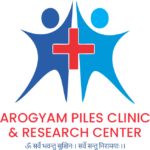What is piles ?
Piles, medically referred to as haemorrhoids, manifest as the consequence of swollen veins and overlying tissue within the anal canal.
Piles are classified in two categories:
1. External piles:- External Piles, also known as external haemorrhoids, develop as a result of bleeding from the external haemorrhoidal venous plexus. This condition occurs when blood accumulates beneath the skin at the anal margin, leading to symptoms such as sudden onset swelling and pain. Patients often seek relief by employing simple measures like hot sitz baths or cold compressions, complemented with anti-inflammatory medication. In cases of severe pain, undergoing a clot evacuation procedure can provide immediate relief from the discomfort associated with external piles.
2. Internal piles : Internal piles, also known as internal haemorrhoids, refer to the swelling of the internal haemorrhoidal venous plexus and the surrounding tissues. These haemorrhoids are further classified into grades I, II, III, and IV based on their size and specific characteristics.
In Grade I piles, the swollen veins are located within the anal canal.
Moving on to Grade II piles, the swollen veins protrude outside during bowel movements and then retract back inside afterwards.
Progressing to Grade III piles, a noticeable mass protrudes during bowel movements but does not recede on its own, requiring manual repositioning.
Lastly, in Grade IV piles, the mass remains protruded outside even if pushed back and tends to reappear.
It is common to observe painless bleeding during bowel movements and itching as prevalent symptoms across the different grades of internal piles. Interestingly, pain associated with internal piles only emerges when the piles mass becomes thrombosed or strangulated, requiring careful attention and management.
What are the causes of piles ?
The primary instigator for this condition tends to be the exertion of excessive pressure during bowel movements, often stemming from instances of constipation or diarrhoea. Moreover, the incidence of piles can also be heightened during pregnancy. Factors such as obesity, engaging in heavy weight lifting practices, smoking, and consuming excessive amounts of alcohol are recognized as contributing elements that accelerate the development of piles. Additionally, maintaining a sedentary lifestyle and prolonged periods of sitting have been identified as pivotal factors that exacerbate the likelihood of piles formation. As age progress the muscles that provide support to the anal canal tend to weaken, thereby fostering the protrusion of veins and culminating in the formation of piles.
What is the treatment of piles ?
When it comes to addressing internal piles, one commonly adopted approach involves conservative management, which emphasizes the implementation of dietary alterations and modifications to one’s lifestyle. These changes typically include the incorporation of a diet that is rich in fibrous elements and ensuring adequate fluid intake on a daily basis. Additionally, it is recommended to steer clear of refined and unhealthy food choices while also making a point to engage in regular physical activity through exercises. The application of these straightforward strategies has been noted to contribute significantly to alleviating symptoms associated with piles. However, in situations where symptoms persist despite these interventions, seeking advice from a specialized piles doctor nearby is advisable.
At the initial stages, such as grade I and II, healthcare providers may opt to prescribe medications like laxatives alongside recommending specific ointments for local application in conjunction with dietary modifications and lifestyle adjustments.
For more progressed instances, such as grade III and IV, surgical interventions like haemorrhoidectomy, Staple haemorrhoidectomy, or LASER piles treatment are frequently suggested by medical professionals.
Additionally, for non-surgical management options, techniques such as rubber band ligation, cryotherapy, and sclerotherapy could also be considered as viable treatments for piles.
What is the best treatment for piles ?
When it comes to choosing the most effective treatment for piles, kshar karma and kshar sutra stand out as exemplary options.
Kshar karma, a non-surgical method for piles treatment, particularly excels in managing grade I and II internal piles. This treatment involves the application of a specialized medication paste directly onto the piles mass, inducing shrinkage and shedding. Notably, kshar karma surpasses rubber band ligation due to the common issue of rubber bands slipping off during bowel movements, which can leave the piles unaddressed. Furthermore, when compared to sclerotherapy, kshar karma proves superior as sclerotherapy injections can lead to deep ulcers, often prone to infection and harm healthy tissues.
For grade III and grade IV piles, kshar sutra emerges as the optimal treatment choice, offering a highly efficient solution. In this procedure, the piles mass is ligated at its base with a kshar sutra while under local anaesthesia, resulting in the shedding of the mass within a week. One of the standout advantages of kshar sutra treatment is that it does not necessitate general or spinal anaesthesia, hospitalization, and can be undergone seamlessly with minimal complications. Moreover, the recurrence rate post kshar sutra treatment in piles is nearly negligible, reinforcing its efficacy and long-term benefits.
Therefore, for those seeking the best piles treatment in Chandigarh, securing a consultation with our skilled Ayurvedic piles specialist at Arogyam Piles Clinic and Research Center situated in Mohali, Punjab, is highly recommended for comprehensive care and effective solutions.




